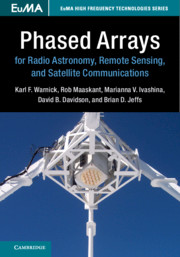Book contents
- Frontmatter
- Contents
- Preface
- Acknowledgements
- Notation and Units
- 1 Phased Arrays for High-sensitivity Receiver Applications
- 2 Active Antenna Receivers
- 3 Antenna Examples
- 4 Transmitting Arrays, Network Analysis, and Pattern Overlap Integrals
- 5 Array Receiver Theory and Modeling
- 6 Figures of Merit for Active Receiving Arrays
- 7 Design and Optimization of Phased Array Antennas
- 8 Numerical Modeling of Phased Array Antennas
- 9 Analog Front End, Array Elements, and Receiver Electronics
- 10 Array Signal Processing, Calibration, and Beamforming
- 11 Interferometric Arrays and Synthesis Imaging
- 12 Real Time Digital Signal Processing
- Index
- References
10 - Array Signal Processing, Calibration, and Beamforming
Published online by Cambridge University Press: 14 July 2018
- Frontmatter
- Contents
- Preface
- Acknowledgements
- Notation and Units
- 1 Phased Arrays for High-sensitivity Receiver Applications
- 2 Active Antenna Receivers
- 3 Antenna Examples
- 4 Transmitting Arrays, Network Analysis, and Pattern Overlap Integrals
- 5 Array Receiver Theory and Modeling
- 6 Figures of Merit for Active Receiving Arrays
- 7 Design and Optimization of Phased Array Antennas
- 8 Numerical Modeling of Phased Array Antennas
- 9 Analog Front End, Array Elements, and Receiver Electronics
- 10 Array Signal Processing, Calibration, and Beamforming
- 11 Interferometric Arrays and Synthesis Imaging
- 12 Real Time Digital Signal Processing
- Index
- References
Summary
The general disciplines of calibrating phased arrays, constructing beam weighting coefficients, and performing computations on the output signals from a phased array system, all belong to broad field known as array signal processing. Basic topics from array signal processing, as well as advanced topics such as radio frequency interference mitigation, are surveyed in this chapter. For phased arrays used in demanding applications like radio astronomy, a priori array calibration methods generally are insufficiently accurate. In practice, array calibration generally involves measured signal responses or correlations with bright sources, so calibration is included here in the same treatment as beamforming and signal processing.
Beamforming
In the context of antenna array receivers, beamforming is the process of linearly weighting and combining signals from array elements in order to form a desired spatial response pattern. An example of response pattern is shown in Fig. 10.1. Beamforming can be viewed as spatial filtering where the discrete-in-space samples of the propagating wavefront (i.e., the outputs of the distinct antenna elements of the array, each in a different position) are used as inputs to a linear filter. Typically the beamformer is designed by adjusting the element weights to achieve higher gain, directivity, sensitivity, and signal to noise ratio than is possible from any single array antenna element. In the process, the high gain field of view is narrowed to a relatively small directional region know as the beam main lobe, or simply the beam. The lower response peaks outside this main lobe region are undesirable artifacts of the beamforming process and are pattern sidelobes.
Beams may be steered to a desired direction by inserting time delays in the signal path of each element to compensate for differential propagation delays across the array for wavefronts arriving from that direction. These time aligned signals sum coherently in the beamformer and so higher gain is achieved in the desired steering direction. For narrowband signals this steering time delay may be replaced by simply multiplying element signal streams by the equivalent complex phase shift e−jωkτi where ωk is the narrowband subband center radian frequency for the kth channel and τi is the alignment time delay correction for the ith element (this is equivalent to the phase shift derived in Sec. 4.1).
- Type
- Chapter
- Information
- Publisher: Cambridge University PressPrint publication year: 2018



